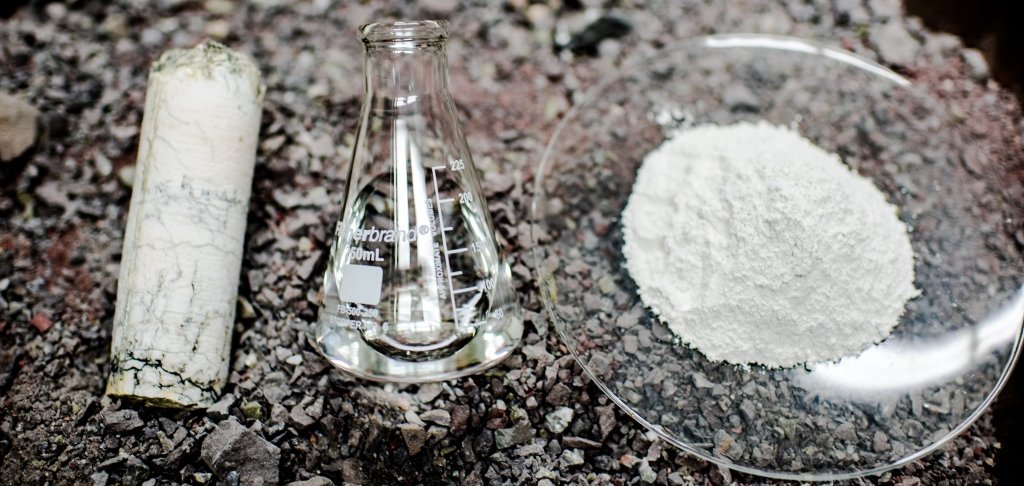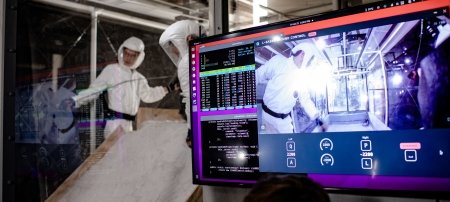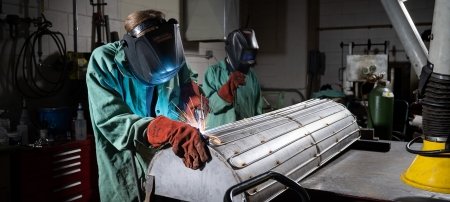Michigan Tech researchers have been awarded a NASA grant to study ways to extract water from gypsum rock on Mars, bringing a human trip to the red planet closer to reality.
Jeffrey Allen is the principal investigator on a project that has received $200,000 first-year funding from the National Aeronautics and Space Administration. Paul van Susante, Ezequiel Medici and Timothy Eisele are co-principal investigators on the project, “Low Mass, Low Power, Non-Mechanical Excavation of Gypsum and Other Evaporites and Water Production on Mars.”
NASA awards Early Stage Innovation grants to help scientists do fundamental, preliminary research to test ideas and advance new technologies. This two-and-a-half-year project, funded for a total of $500,000, will investigate whether robots sent to Mars can use powerful jets of water to excavate gypsum, blast the rocks to disintegrate them, and heat the gypsum particles to release the water bound within mineral’s crystal structure. This could be a way to expeditiously make more water and oxygen for human consumption and to make rocket fuel on Mars.
This work aims to create a way for NASA (or a space exploration contractor) to send humans to Mars with enough water, oxygen and rocket fuel for the trip out, knowing that there will be enough water, oxygen and rocket fuel waiting on Mars for the astronauts to use on their trip home to Earth.
Breaking It Down
If mining machinery breaks down on Earth, fixing the problem is expensive, but it’s also just a phone call away. There are no mechanics on Mars; therefore, coming up with a way to mine that causes the least wear on machines was the starting point for a project occurring millions of miles away.
“How could you mine hard rock knowing these machines have to operate for many years without maintenance?” asks van Susante, senior lecturer in mechanical engineering-engineering mechanics and faculty advisor to the Mining Innovation Enterprise (MINE) team. “The problem is the metal that exerts the force to break the rock. Metal wears down or breaks off, requiring maintenance. We’re trying to eliminate that part of it. We came up with idea to use a water jet, or some other gas or liquid, that we can spray at high pressure at the rock. It’s a new idea in space that hasn’t been proposed before.”

Working with Tim Eisele, assistant professor of chemical engineering and endowed faculty fellow, and students from the MINE team, van Susante is creating a sealed chamber in the Ore Separation Laboratory and Benedict Laboratory equipped with water jets to disintegrate gypsum samples. The second step is to transport the resulting slurry for separation to remove suspended particles and supply the water back to the pressure washer.
Their plan is to feed water back into the system until there is a surplus, at which point the water will be stored. The water can then be separated and combined with carbon from the Martian atmosphere to create methane for rocket fuel and liquid oxygen is a byproduct .
One of the more puzzling aspects of the project is determining how to best create a seal between the chamber and ground to trap heat, increase pressure and minimize water loss—a tricky proposition on the rough surface of the red planet. This and other aspects will be tested under simulated Martian conditions. Ezequiel Medici, research assistant professor and instructor in mechanical engineering-engineering mechanics, will model thermal and fluid interactions between the regolith—soil lacking organic compounds—and subsurface of the ground.
Other factors that are difficult to predict include the distances robots would have to travel between the excavation site and storage areas. To put the current difficulties of travel on Mars in perspective, all of the rovers have traveled approximately 26 miles—a literal marathon on tiny treads. Put simply, the shorter the distance the better, to keep robots producing water and components for fuel.
“Our goal is to do this with the minimum amount of energy and the minimum amount of mass,” van Susante says.
The team hopes to achieve a production rate of disintegrating four to five kilograms of gypsum per hour. At that rate, oxygen, water and propellant tanks are estimated to be ready and waiting for humans, approximately 480 Mars days (known as sols) after the production robots land on Mars.
A Mission with Moxie
NASA plans to send the Mars Oxygen In-Situ Resource Utilization Experiment (MOXIE) mission to Mars in 2020 to demonstrate oxygen production from the Martian atmosphere. The fundamental research the team at Michigan Tech is doing, along with related research at other universities, needs to work out the kinks in the system to extract water on Mars for the methane production for future demonstration and human missions to Mars.
“Why do we care about this? The reason we care is because rocket fuel is such a huge amount of the rocket,” van Susante says. “Of any rocket you send to space, 88 percent of that rocket’s mass is fuel—enough fuel just to get from here to low-Earth orbit. That means the 12 percent you have left must include the fuel to get to Mars, to the surface of Mars, back off the surface of Mars, and back Earth. It’s like going from New York to LA and you have to bring everything with you—the air, the food, the gasoline—and you’re not allowed to use anything around you; no pit stops!”
This means manufacturing air, water and fuel at the mission destination. It is van Susante’s hope that by the mid-2030s—a mere 15 years from now—humans will land on the surface of Mars.
Michigan Technological University is an R1 public research university founded in 1885 in Houghton, and is home to nearly 7,500 students from more than 60 countries around the world. Consistently ranked among the best universities in the country for return on investment, Michigan's flagship technological university offers more than 120 undergraduate and graduate degree programs in science and technology, engineering, computing, forestry, business, health professions, humanities, mathematics, social sciences, and the arts. The rural campus is situated just miles from Lake Superior in Michigan's Upper Peninsula, offering year-round opportunities for outdoor adventure.






Comments